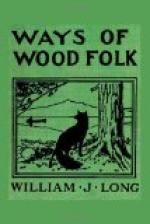You can go home now; you will see nothing more to-night. There’s a beaver over under the other bank, in the shadow where you cannot see him, just his eyes and ears above water, watching you. He will not stir; nor will another beaver come out till you go away. As you find your canoe and paddle back to camp, a ripple made by a beaver’s nose follows silently in the shadow of the alders. At the bend of the river where you disappear, the ripple halts a while, like a projecting stub in the current, then turns and goes swiftly back. There is another splash; the builders come out again; a dozen ripples are scattering star reflections all over the pool; while the little wood folk pause a moment to look at the new works curiously, then go their ways, shy, silent, industrious, through the wilderness night.
VII. CROW-WAYS.
[Illustration]
The crow is very much of a rascal—that is, if any creature can be called a rascal for following out natural and rascally inclinations. I first came to this conclusion one early morning, several years ago, as I watched an old crow diligently exploring a fringe of bushes that grew along the wall of a deserted pasture. He had eaten a clutch of thrush’s eggs, and carried off three young sparrows to feed his own young, before I found out what he was about. Since then I have surprised him often at the same depredations.
An old farmer has assured me that he has also caught him tormenting his sheep, lighting on their backs and pulling the wool out by the roots to get fleece for lining his nest. This is a much more serious charge than that of pulling up corn, though the latter makes almost every farmer his enemy.
Yet with all his rascality he has many curious and interesting ways. In fact, I hardly know another bird that so well repays a season’s study; only one must be very patient, and put up with frequent disappointments if he would learn much of a crow’s peculiarities by personal observation. How shy he is! How cunning and quick to learn wisdom! Yet he is very easily fooled; and some experiences that ought to teach him wisdom he seems to forget within an hour. Almost every time I went shooting, in the old barbarian days before I learned better, I used to get one or two crows from a flock that ranged over my hunting ground by simply hiding among the pines and calling like a young crow. If the flock was within hearing, it was astonishing to hear the loud chorus of haw-haws, and to see them come rushing over the same grove where a week before they had been fooled in the same way. Sometimes, indeed, they seemed to remember; and when the pseudo young crow began his racket at the bottom of some thick grove they would collect on a distant pine tree and haw-haw in vigorous answer. But curiosity always got the better of them, and they generally compromised by sending over some swift, long-winged old flier, only to see him go tumbling down at the report of a gun; and away they would go, screaming at the top of their voices, and never stopping till they were miles away. Next week they would do exactly the same thing.




